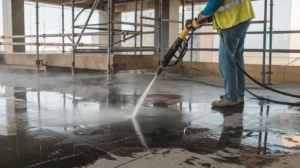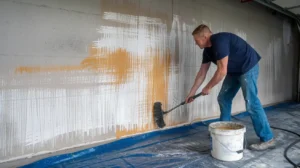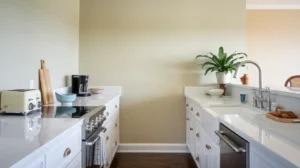How to Clean Concrete Floor effectively is essential to maintaining...
Read MoreAchieving a smooth transition between different flooring materials, especially in the kitchen, is key to both aesthetics and functionality. A thoughtfully selected transition can significantly elevate the overall look and ambiance of the room.
This is particularly important when pairing kitchen tiles with wood flooring. The right transition creates a seamless, visually pleasing flow between the two materials. In this article, we explore 10 great ideas for transitioning from kitchen tile to wood flooring, providing both practical tips and creative design solutions.
These ideas aim to make the connection between your tile floors and hardwood floors both beautiful and functional, elevating the overall aesthetic of your kitchen.
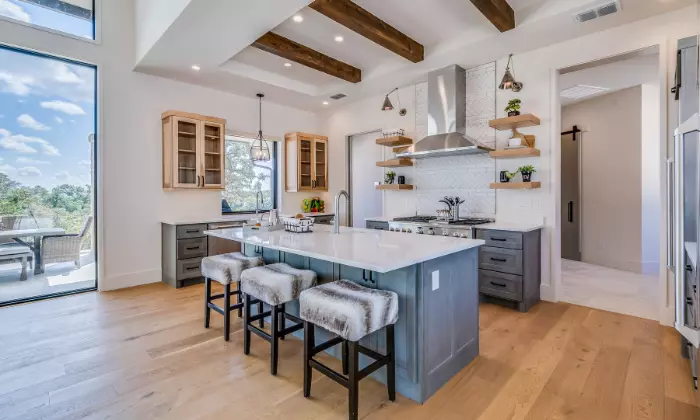
10 Kitchen Tiles to Wood Floor Transition Ideas
Let’s dive into some exciting kitchen tile to wood floor transition ideas. From seamless flush borders to intricate decorative borders, we’ve got it all covered. We’ll explore how herringbone patterns and tile to wood floor transition strips can enhance the look of your kitchen.
Check out the following cool kitchen floor transition tips that can enhance the beauty of your kitchen floor, including marble restoration.
Metal Strip Transition
A metal strip transition is a straightforward and efficient method for connecting kitchen tiles to wood flooring. These strips, typically crafted from aluminum or brass, offer a sleek and contemporary appearance while safeguarding the edges of both flooring materials.
Available in a range of finishes to complement your decor, metal strips are easy to install and maintain. They are particularly advantageous in high-traffic areas, as they protect the vulnerable edges of the tile and wood, preventing damage and wear. This type of transition ensures a durable and stylish connection, enhancing both the functionality and aesthetics of your kitchen floor.

Mosaic or Threshold Transition
Mosaic or threshold transitions provide stylish solutions for merging tile and wood flooring. Mosaic transitions use small, decorative tiles to create a beautiful border that acts as a functional barrier between the two flooring types.
This approach adds an artistic and unique touch to your kitchen decor. Threshold transitions, alternatively, involve a single strip of a different material, such as marble or engineered marble, to bridge the gap between tile and wood.
This method offers a sleek, polished look that seamlessly connects the two flooring styles. Both options enhance the aesthetic appeal and practicality of your kitchen floor.

End-Cap Transition
An end-cap transition uses a piece of wood molding to cap the edge of wood flooring where it meets a tile floor. This technique creates a smooth and gradual transition between the two different flooring types, ensuring a cohesive look.
End-cap transitions are particularly effective in managing different flooring heights, providing a level and safe passage. This type of transition is both functional and aesthetically pleasing, blending seamlessly with the existing decor.
The molding serves as a protective barrier for the flooring edges, preventing wear and tear. Overall, end-cap transitions offer a practical and stylish solution for connecting kitchen tile and wood floors.

Blended Flow Transition
A blended flow transition is an advanced flooring technique that merges tile and wood flooring pieces together gradually. This approach creates a seamless and flowing transition, offering both visual appeal and practicality.
By carefully selecting and placing the tiles and wood planks, homeowners can achieve a unique and cohesive look. This method enhances the overall design of the kitchen, making it feel more integrated and harmonious.
The blended flow transition stands out for its ability to smoothly combine different materials, textures, and colors, providing a custom, high-end aesthetic. It’s perfect for open-plan kitchens where a continuous look is desired without abrupt changes between flooring types.

Border Transition
Border transitions use a strip of material, like wood or tile, to create a clear boundary between different flooring types. This method is particularly useful in open-plan kitchens to separate areas such as the cooking space from the dining area.
Border transitions offer flexibility in design, allowing for simple, clean lines or more intricate patterns, depending on your preference. They can be customized to match or contrast with the existing flooring, enhancing the overall aesthetic.
This type of transition not only adds visual interest but also helps to define and organize the kitchen space effectively. Whether you opt for a subtle or bold border, it provides a practical and stylish solution for connecting tile and wood floors.
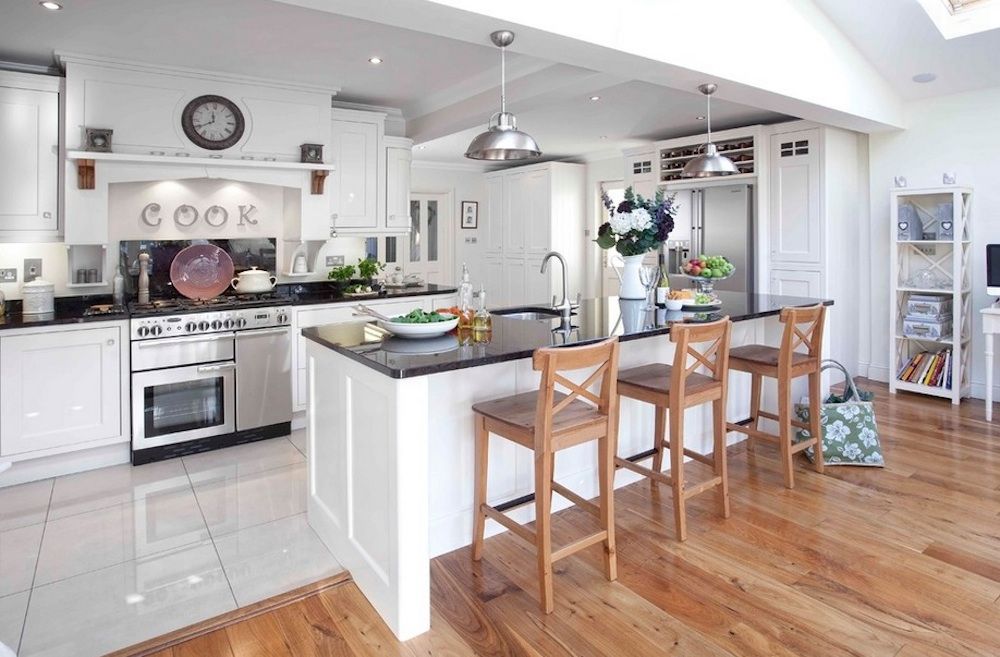
Diagonal Transition
A diagonal transition in kitchen flooring design deviates from the traditional straight alignment of tile and wood flooring by laying them at an angle. This approach introduces a dynamic element, creating visual interest and a sense of movement in the space.
By breaking away from straight lines, diagonal transitions can visually expand the kitchen area, making it feel more spacious and open. This method not only enhances the aesthetic appeal but also adds a stylish twist to the overall flooring layout, offering a unique and contemporary look to your kitchen environment.

Herringbone Transition
The herringbone transition involves laying tiles or wood planks in a distinctive zigzag pattern, resembling the skeleton of a herring fish. This method not only connects tile and wood flooring but also enhances the aesthetic appeal of any space.
Its sophisticated appearance adds a touch of elegance and luxury to kitchens and other areas. By using contrasting colors and materials, such as dark and light wood or bold tile patterns, the herringbone pattern accentuates the individual characteristics of each flooring type.
This technique is admired for its ability to create a visually striking and dynamic transition that stands out while seamlessly integrating into the overall design scheme.

Flush Transition
A flush transition involves aligning tile and wood flooring at the same level, achieving a seamless surface. It’s favored for its minimalist appeal, blending different materials without visible breaks.
Precision during installation is crucial to ensure a perfectly even alignment between the two surfaces. This method creates a sleek and continuous look, ideal for contemporary interior designs. The absence of height differences enhances safety and accessibility in spaces like kitchens and living areas.
A well-executed flush transition contributes to a unified aesthetic, emphasizing the clean lines and simplicity of modern decor. Its seamless integration makes the transition virtually invisible, maintaining the flow and spacious feel of the room.

Decorative Transition
Decorative transitions in flooring allow for extensive customization and personal expression. By incorporating decorative tiles, intricate wood patterns, or bespoke designs, homeowners can craft a transition that is distinctly their own, showcasing their style preferences and enhancing the kitchen’s visual appeal.
This creative approach provides flexibility with colors, textures, and shapes, enabling unique combinations that elevate the entire kitchen space. Whether opting for vibrant tiles, detailed wood inlays, or custom motifs, each choice contributes to a personalized design statement that sets the kitchen apart and reflects the individuality of its owners.

Medallion Transition
A Medallion Transition is a decorative feature placed where tile and wood flooring meet, serving as a focal point in the kitchen floor. Typically made from materials like marble, granite, or engineered marble, medallions can be customized to complement your kitchen’s design, particularly in contexts such as granite restoration.
They add both beauty and functionality by seamlessly blending different flooring materials while creating an eye-catching element. Medallions come in various shapes, sizes, and designs, allowing for personalization to suit your aesthetic preferences.
Whether intricate or minimalist, these transitions enhance the overall appeal of your kitchen, making them a popular choice for homeowners aiming to elevate their interior decor with a touch of elegance and style.

Why Stone Sealer Is Best Choice For Kitchen Tile To Wood Floor Transition
Stone Sealer is an ideal choice for kitchen tile to wood floor transitions due to its unique formulation designed to protect both natural stone and grout. As a leading brand in the market, Stone Sealer offers a specialized solution that not only enhances the aesthetic appeal of tiles but also ensures long-term durability.
Its advanced formula penetrates deep into the pores of stone surfaces, creating a protective barrier that prevents moisture penetration and stains, crucial in high-moisture areas like kitchens. This protection is particularly valuable at transition points between tile and wood, where different materials meet and are vulnerable to wear and moisture damage.
By using Stone Sealer, homeowners can effectively maintain the beauty of their floors while safeguarding against the challenges posed by transition zones, ensuring a seamless and durable flooring solution throughout the kitchen area.
Conclusion
Choosing the right tile to wood floor transition is crucial for creating a cohesive and visually appealing kitchen. Whether you prefer a simple metal strip transition or a more elaborate mosaic or medallion transition, there are plenty of options to suit your style and practical needs.
By exploring these 10 ideas, you can find the perfect solution for your kitchen, ensuring a seamless and beautiful connection between your tile floors and hardwood floors. Remember, the key to a successful floor transition lies in careful planning, precise installation, and a keen eye for design.
Using Stone Sealer allows homeowners to preserve the elegance of their floors while protecting against the specific challenges of transition zones. This ensures a smooth and long-lasting flooring solution that enhances the overall appeal of the kitchen area.
FAQs
How to transition between tile and wood floor?
Transitioning between tile and wood floors can be achieved using various methods such as metal strips, threshold transitions, end-cap transitions, or blended flow transitions. These techniques help create a seamless and aesthetically pleasing connection between different flooring materials.
How to combine wood and tile flooring?
Wood and tile flooring can be combined effectively by choosing complementary colors, patterns, and transition methods. Options include using borders, medallions, or diagonal layouts to blend the two materials smoothly, enhancing the overall visual appeal of your space.
How do you transition from tile to wood in an open floor plan?
Transitioning from tile to wood in an open floor plan involves ensuring a smooth flow between the two flooring types without abrupt changes. Techniques like flush transitions or creating zones with different flooring materials can help maintain continuity while defining separate areas within the open space.
Can I put a wood floor over the tile?
Yes, you can install wood flooring over existing tile, provided the tile is in good condition, clean, and level. Proper preparation, such as using a suitable underlayment and adhesive, is crucial to ensure the wood flooring adheres securely and maintains durability over time.
Do You Need a Transition Strip Between Hardwood and Tile?
Whether you need a transition strip between hardwood and tile depends on several factors, including the height difference between the two floors, the type of installation, and aesthetic preferences. Transition strips like metal strips or T-moldings can help create a smooth and safe transition while protecting the edges of both flooring types.
Our Services
Our Recent Post
How to Remove Paint from Concrete
How to Remove Paint from Concrete can be a challenging...
Read MoreTop 7 Popular Quartz Countertops Colors in 2024
Quartz countertops colors are at the forefront of modern interior...
Read MoreHow to Clean a Granite Composite Sink | Simple Steps for a Spotless Finish
How to Clean a Granite Composite Sink starts with understanding...
Read More
